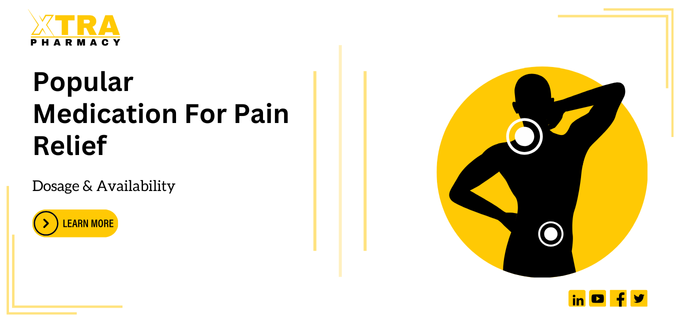Pain is an unpleasant sensation due to actual or potential tissue damage. However, there are popular medication for pain relief. Some occur for a few days, and some for months to years. Choosing the best treatment and medication is crucial in people’s lives. With the help of this blog, you will learn about a few popular medication for pain relief.
Introduction
Pain is the most common reason people see a doctor. It can be acute, meaning it lasts for a short duration, and chronic, meaning it lasts more than three months. Injuries such as cuts, burns, or broken bones often cause acute pain. A variety of conditions, such as arthritis, cancer, and back pain, can cause chronic pain.
Pain can be mild, moderate, or severe. Mild discomfort is usually described as annoying or uncomfortable. Moderate pain is more intense and can interfere with daily activities. Severe pain is debilitating and can make it difficult to move or think.
Pain can be a physical, emotional, and social problem. It causes physical symptoms like headaches and fatigue. It can also become the cause of emotional issues like depression, anxiety, and irritability. Pain can also interfere with social activities like work, school, and relationships.
There are a variety of treatments for pain, including medication, surgery, physical therapy, and psychological therapy. The best pain treatment depends on the reason for the pain and the individual’s needs.
Overview
Medication for pain relief, also known as analgesics, are drugs used to relieve pain. They work by interfering with transmitting pain signals from the nerves to the brain. Pain medications are classified into two main categories: non-opioid and opioid.
Non-opioid pain medications (NSAIDs), like ibuprofen (Advil) and naproxen (Aleve), relieve pain without causing drowsiness or altering consciousness. NSAIDs also have anti-inflammatory effects, which can help reduce swelling and inflammation associated with pain.
Other Drugs
Opioid pain medications, such as morphine, Oxycodone (OxyContin), and hydrocodone, are more potent than non-opioid medication for pain relief and are used for treating severe pain. Opioids work by binding to opioid neurons found in the brain and spinal cord, and they block all the pain signals from being transmitted to the brain.
However, opioids can also cause side effects such as drowsiness, constipation, nausea, and vomiting.
The choice of pain medicines depends on the tolerance and duration of the pain, the underlying cause of the pain, and the individual’s medical history. Some pain drugs are available over the counter, while others need a prescription from a physician. Following the dosing guidance your doctor or pharmacist provides is vital to avoid potential side effects.
List of Popular Medication For Pain Relief
Some pain medications are highly effective and help you cure your pain instantly.
Tramadol
Tramadol is specified for the management of mild to moderately severe pain in grown-ups and adolescents aged 12 and above.
Tramadol extended-release tablets and capsules are specifically for individuals requiring continuous pain relief. It belongs to a group of drugs known as opiate (narcotic) analgesics and functions by altering the brain and nervous system’s response to pain.
Percocet
Percocet is a prescription medication for pain relief containing Oxycodone, a potent opioid pain reliever, and acetaminophen, a non-opioid pain reliever. It is utilized for managing both short-term and long-term pain through dual mechanisms.
In this, the component called Oxycodone binds to opioid receptors in the brain, lowering pain signals, while acetaminophen amplifies the overall pain-relieving effects. Percocet is available in various strengths, and the dosage is tailored to individual pain levels.
Due to its opioid content, there is a potential for dependence and misuse. Therefore, it should be used under close medical supervision. Patients are suggested to follow the prescribed dosage and seek personalized guidance from healthcare professionals.
Oxycodone
Oxycodone is prescribed for the medication for pain relief form moderate to severe. It is specifically used for individuals who require continuous, long-term pain relief and are unable to be treated with alternative medications. Oxycodone should not be used for pain that can be managed with as-needed medication.
Dosage
Tramadol Dosage
Usual adult dose for pain: The typical starting dose is 50mg after every 4-6 hours for pain relief.
The maximum suggested dose is 400 mg per day.
The usual dose of Adults for chronic pain: For individuals 18 years or older who have not taken Tramadol, the recommended starting dose is extended-release.
Tramadol is 100mg taken orally once a day. The dose can be adjusted in increments of 100 mg every five days until an effective dose with minimal side effects is reached.
The maximum daily dose should be at most 300 mg.
Percocet Dosage
Take 5mg to 15 mg of Oxycodone every 4 to 6 hours as needed for pain relief.
For acetaminophen, take 325mg to 650 mg every 4 to 6 hours.
A maximum of 4000 mg in 24 hours.
Oxycodone Dosage
Typical Adult Dosage for Pain
The recommended dosing for immediate-release medication for pain relief is 5mg to 15mg taken orally every 4 to 6 hours as the first opioid analgesic.
When using the oral solution, including the total dose in milligrams and milliliters is essential to prevent dosing errors.
These suggestions should be considered as part of a series of clinical decisions made over time.
Carefully observe patients for signs of breathing difficulties during the initial 24 to 72 hours of starting treatment and after any adjustment in dosage.
Side Effects
Tramadol Side Effects
Tramadol can result in side effects. Tell your physician if any of these symptoms are intense or persistent drowsiness, headache, anxiety, involuntary trembling of a specific body part, alterations in mood, acid reflux, upset stomach, and lack of saliva(dry mouth).
Percocet Side Effects
Some common side effects of Percocet may include Feeling dizzy, drowsy, or tired; Experiencing headaches; Dealing with constipation, nausea, vomiting, or stomach pain; Feeling itchy, having red eyes, or flushing; Experiencing dry mouth.
Oxycodone Side Effects
Please get in contact with your physician immediately if you experience: – Loud or irregular breathing, shallow breathing, or pauses in breathing while sleeping, Feeling dizzy or like you might faint – Confusion, unusual thoughts, or unusual behavior – Seizures – High levels of serotonin in the body – restlessness, hallucinations, fever, sweating, shivering, rapid heartbeat, muscle stiffness, twitching, loss of coordination, nausea, vomiting, or diarrhea.
Precaution
Tramadol Precaution
Tramadol is a prescription-based drug and should only be taken under the supervision of a healthcare professional. Notify your physician about your medical history, especially if you have a history of seizures, kidney or liver disease, mental health disorders, or substance abuse. If you have known allergies to Tramadol or its components, inform your doctor.
Tramadol can interact with other drugs, including other pain relievers, antidepressants, sedatives, and herbal supplements. Tramadol should be used with caution during pregnancy and breastfeeding. It should also be used with caution in children under 12 years old and in elderly patients due to an increased risk of side effects.
Percocet Precaution
Do not take Percocet if you have consumed alcohol, sedatives, tranquilizers, or other opioid medications recently.
Avoid using Percocet if you have taken an MAO inhibitor in the last 14 days. It can slow or stop your breathing and may lead to dependence. Take the dose as prescribed and swallow the pill whole to prevent a potentially fatal overdose. Never share Percocet with someone else.
Stop taking this medication and call your doctor right away if you develop skin redness or a rash that spreads and leads to blistering and peeling.
Do not use Percocet in case of pregnancy and breastfeeding. Using Percocet with alcohol or other drugs that cause drowsiness or slow breathing can result in fatal side effects.
Oxycodone Precaution
Always take Oxycodone as instructed by the pharmacist for the best results. Oxycontin is the best medication for pain relief, so avoid misusing or overdosing on it.
Also, before making any changes or if you have any family history of drug abuse or addiction, then inform your doctor about it. Also, it is suggested not to take Oxycodone if you are a pregnant or breastfeeding mother.
Taking Pain Relief Drugs
You can take all the medication for pain relief as per your needs and suggestions. Also, for best results, always stick with the prescription list.
For best results, do not overdose or stop using your pain medications. You will soon see improvement and better responses if you continuously follow your prescription dosage.
Conclusion
In conclusion, while pain relief drugs like Percocet and Tramadol can provide effective relief from moderate to severe pain, they must be used cautiously and as prescribed by a healthcare professional.
To minimize risks, patients should communicate openly with their doctors about their medical history, including any allergies or existing conditions.
Additionally, alternative pain management strategies and non-pharmacological approaches should be explored whenever possible to reduce reliance on opioid-based medication for pain relief and mitigate the risk of dependence and adverse effects.

